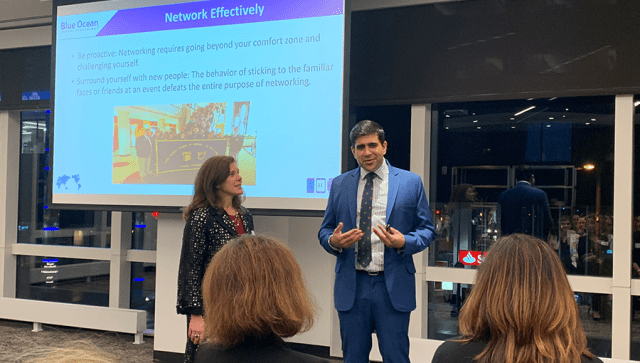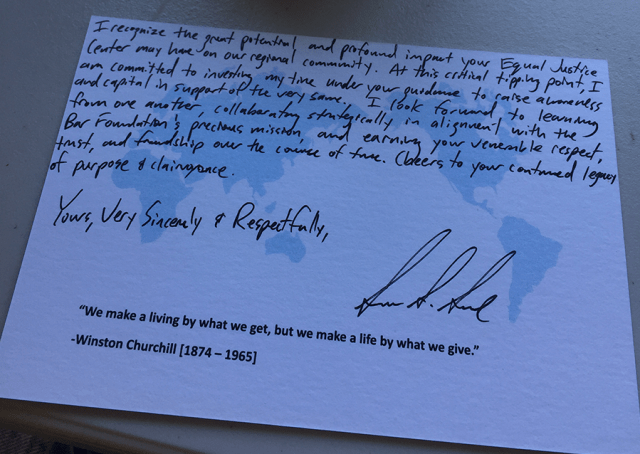[ad_1]
Do you have a strategy for building trust, respect, and friendship with the various contacts you’ve made at conferences and networking events?
Now, amid the coronavirus epidemic and global lockdown, having such a plan in place is more critical than ever.
First impressions matter, but we build meaningful relationships through ongoing communication and impactful exchanges. And that may be truer today than it was before the current crisis.
Certain expectations arise during first conversations, both online and in-person, and as a professional, you have an opportunity — some might even say a duty — to meet or exceed those expectations. Doing so helps create the strong foundation that underpins relationship capital.
To positively engage with someone, share your contact information, and then never hear from them again is both frustrating and disappointing. Perhaps, like me, you have found yourself on both sides of this equation at one time or another.
The fortune is in the follow-up. The reality is that progressing from a first conversation to truly understanding someone and becoming their friend takes time and multiple interactions. If your initial encounter is the seed, your follow-up is the sunlight and water required to grow that encounter into a fruitful connection. Making new contacts is pointless if you don’t invest the time to reach out to them afterward to strengthen the bond. This is the only way to give those new relationships a chance to develop.
But you need to ensure a balance between cultivating your new connections and maintaining the relationship capital you have already built with existing clients and associates. The latter’s trust in you can easily erode when you are not contacting them or responding to their communications.
That’s crucial to remember today. Most of us are away from the office. We’re working from home, distracted. And those relationships that may have been easy, because we regularly ran into people at the office or attended the same events, now take a little more effort and forethought.
“Do something for your client and they will appreciate you that day. Do something for their children, and they are your friend for life.” — Vickie Neighbour, chairperson, Society of International Business Fellows (SIBF)
Here are seven strategies you can use to nurture the connections you’ve made and maximize touchpoints with the people in your network.

1. Categorize Your Contacts.
Sort through the contact information you have gathered and arrange your acquaintances into groups. You might choose to categorize them according to the type of information you wish to share with them, or you might arrange them in order of priority.
Some of your contacts might have more urgent needs than others, or you may have connected with some of them more strongly and feel compelled to reinforce those associations sooner. In certain cases, you might need to conduct further research before deciding how best to reach out. If your goal is to follow up quickly and effectively, creating a hierarchy clarifies who your first follow-up should be.
Communications are easier when you can readily see which contacts have similar interests. This way you can share information or messages with several contacts as a group rather than one at a time.
2. Curate Your Online Image.
These days your digital presence is your principal presence and the first impression is critical. Anyone you meet virtually or in person may at some point Google you. Their quick research on you and your business will influence whether or not they work to further the relationship.
So regularly review what populates when you type your name and that of your company into the search engines. Make sure that accurate, relatable information is at the forefront. Your digital presence should always reinforce the positive impression you have worked to cultivate offline.
3. Use Social Media Strategically.
Before posting to Twitter, LinkedIn, or any other social channel, research the common hashtags before selecting several that best apply to the content you wish to share. Also research and tag contacts for whom the content may be of particular interest and who might wish to amplify your message.
When event organizers or attendees share interesting videos or recaps, comment on them. When you see a post by someone with whom you would like to build a deeper relationship, take a moment to like, comment on, or share it, and leave a thoughtful message. Do more than just click a button. Your engagement will be noticed.
Of course, share only those posts that are relevant to you and your potential connections. If the post is not pertinent to your type of business or client, it’s probably not worth disseminating. When you share information, your social media followers naturally assume that it is relevant to you, so avoid confusing potential or active clients and associates and focus strictly on meaningful content.
4. Establish Online Connections.
Social media can also facilitate direct connections with your contacts. LinkedIn is particularly valuable. Most business professionals have LinkedIn profiles and many have Facebook accounts or pages through which they engage with business associates. Read your contacts’ posts and send connection requests with relevant notes about how or where you met and the primary topic you discussed at that time.
Personalize these requests. Make them meaningful. Avoid generic messages and don’t blatantly solicit business. Just as you wouldn’t ask someone to marry you on a first date, don’t try to sell to a potential business contact during the “getting to know you” phase. Remember: Likeability is a key determination in people’s choice of business partners. In fact, research by the Carnegie Institute of Technology shows that just 15% of success is due to technical knowledge, whereas 85% depends on communicating and connecting with others.
5. Tailor Your Communications.
Vary the channels through which you communicate with your contacts. Learn how each person prefers to be contacted when you first meet and and follow-up through that medium afterward. This demonstrates that you noted and respect their preference and sets the stage for gaining their trust. Afterward you can vary the communication channels somewhat to make an even stronger impression.
One of the easiest and most powerful ways to stand out? Send your new contact a short handwritten note thanking them for the time they invested with you. Such an approach requires more effort and consideration to compose than a simple email, so these communiques are best reserved for those with whom you know you want to develop a stronger working relationship. Be thoughtful in your messaging. One size does not fit all. So don’t send the same note to multiple contacts at the same office. Invest the time to craft something specific and unique to each person.

Another great tool: An actual telephone call. These have become so rare as to seem like an innovation. And an especially effective one. Why? Because it lets people hear the sincerity in your voice. The written word just can’t compare.
So work on your phone manner. As more and more people hide behind digital correspondence, this can help you stand out. And people appreciate it. Those who I call regularly often thank me for taking the time to do so. Creating that verbal connection helps differentiate yourself, even if all you do is leave a voicemail. I make of point of leaving enthusiastic and energetic voice messages. This lets the recipients know that I am genuinely interested in learning more about them.
6. Deliver Value.
To earn or reinforce a contact’s trust, seek out helpful information in their areas of interest — business related or otherwise — and share it with them. This is where listening and note-taking skills are essential.
Offer to introduce them to contacts with similar interests or who may need their product or service. Too often, people approach networking as a zero-sum game: They focus only on what they can get out of it. But truly effective networking is about giving. Make an honest effort to give without remembering and receive without forgetting.
7. Stay the Course.
Tactful persistence is key to success in business. You might need to follow up with someone 20 times or more before you create real relationship capital. Always be professional and consistent with your approach. Set reminders for yourself about who to contact next, when, and how. This will help you stay organized. Take notes on every interaction. This will help you determine the direction your subsequent communications should take.
“One of the best business and networking decisions I made early in my career was to be consistent in my message when building relationships,” says Ian Robertson, CFA, a past president of the CFA Society Vancouver. “Over time this consistency provided three advantages: best practices to efficiently maintain and expand my personal latticework of friends and advocates; clarity on opportunities to create value for others though my core competencies; and a reputation for leveraging new technologies when adopted across the communities I serve.”
These strategies can help you build trust and genuinely connect with the people you meet at both in-person and virtual events, conferences, and through others in your network. Each interaction you have with a contact is a precious opportunity to make a positive contribution to your developing relationship. The capital you build can prove valuable later on, when the time is right for business decisions to be made.
If you liked this post, don’t forget to subscribe to the Enterprising Investor.
All posts are the opinion of the author. As such, they should not be construed as investment advice, nor do the opinions expressed necessarily reflect the views of CFA Institute or the author’s employer.
Image credit: ©Getty Images / LeoPatrizi
Professional Learning for CFA Institute Members
CFA Institute members are empowered to self-determine and self-report professional learning (PL) credits earned, including content on Enterprising Investor. Members can record credits easily using their online PL tracker.
[ad_2]
Image and article originally from blogs.cfainstitute.org. Read the original article here.


